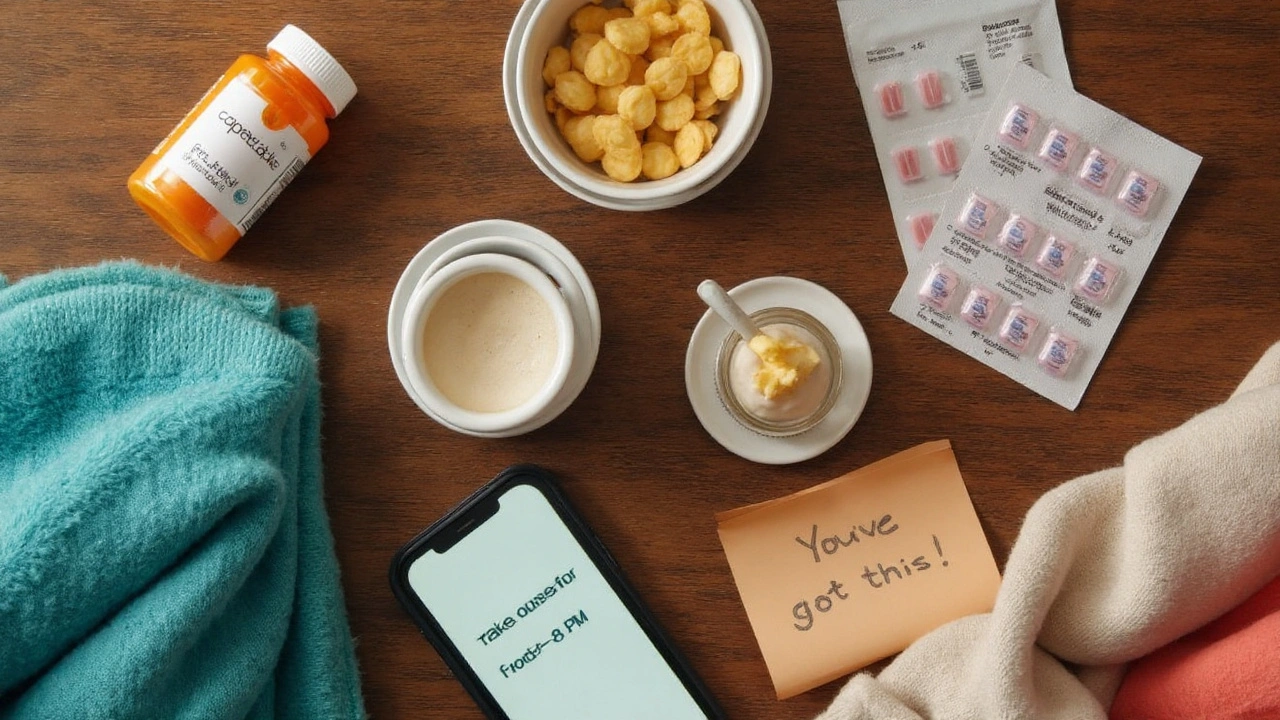Capecitabine for Preventing Cancer Recurrence: Evidence, Dosing, and Safety Tips

The promise is simple but huge: cut the risk that cancer comes back after surgery or initial treatment. The question is whether capecitabine, an oral chemotherapy, actually does that-and for whom. Here’s the short answer: in certain cancers and settings, yes, it lowers recurrence risk and can improve survival. But it’s not for everyone, and using it well means getting the right dose, the right duration, and fast help if side effects show up.
- TL;DR: Capecitabine reduces recurrence risk in specific adjuvant settings-especially HER2-negative breast cancer with residual disease (CREATE-X) and stage III colon cancer (X-ACT/CAPOX data). It’s also key in gastric and rectal protocols.
- Who benefits: Patients with stage III colon cancer, some high-risk stage II colon cancer, HER2-negative breast cancer with residual disease after neoadjuvant therapy, and post-gastrectomy patients on XELOX. Your exact risk and regimen matter.
- How it works: It’s a prodrug of 5-FU, taken as pills in cycles, often alone or with oxaliplatin (CAPOX/XELOX). Duration ranges from 3 to 8 cycles (breast) or 3-6 months (colon) depending on risk and tolerance.
- Side effects are manageable: Hand-foot syndrome, diarrhea, mouth sores, and fatigue are common. Early reporting and dose tweaks prevent serious problems. DPD deficiency and kidney issues require caution.
- Talk to your team if: You’re node-positive colon cancer, had residual HER2-negative breast cancer after chemo, or had D2 gastric surgery. If you’re on warfarin, have kidney disease, or have a history of chest pain with 5-FU, your plan may change.
Why Capecitabine Helps Prevent Recurrence: What the Evidence Says
Capecitabine is a prodrug that turns into 5-fluorouracil (5-FU) inside tumor tissue. By hitting cells that divide fast, it mops up microscopic disease left behind after surgery or initial therapy-the cells that can seed a recurrence. It’s been studied across colon, breast, gastric, and rectal cancers in the adjuvant or perioperative setting.
What the strongest trials show:
| Trial | Cancer Type | Population | Regimen | Key Result | Source |
|---|---|---|---|---|---|
| X-ACT (2005; 2009 update) | Colon (Stage III) | Post-op | Capecitabine vs bolus 5-FU/LV | Non-inferior DFS; OS benefit at update (HR ~0.86) | NEJM 2005; Ann Oncol 2009 |
| IDEA Collaboration (2018) | Colon (Stage III) | Post-op | 3 vs 6 months oxaliplatin-based (CAPOX/FOLFOX) | 3 months CAPOX non-inferior in low-risk (T1-3N1); high-risk often needs 6 months | NEJM 2018 |
| CREATE-X (2015) | Breast (HER2-, residual after neoadjuvant) | High-risk residual disease | Capecitabine vs none | Improved DFS (74.1% vs 67.6%) and OS (89.2% vs 83.6%); biggest gain in triple-negative subgroup | NEJM 2015 |
| CLASSIC (2012; follow-up 2015) | Gastric | Post D2 gastrectomy | XELOX (capecitabine+oxaliplatin) vs surgery alone | DFS and OS improved; established XELOX as adjuvant standard | Lancet 2012; JCO 2015 |
| Rectal CRT Data (multiple) | Rectal | Pre-op chemoradiation | Capecitabine with radiation | Similar efficacy to infusional 5-FU; improves local control with RT | ESMO/NCCN guideline summaries 2023-2024 |
What that means in plain terms: if your team is trying to push the risk of recurrence down after surgery, capecitabine-alone or paired with oxaliplatin-can match or beat older 5-FU regimens, with the convenience of pills. In HER2-negative breast cancer with residual disease after neoadjuvant chemo, it adds a survival bump we didn’t have before.
Guideline vibe as of 2024: ASCO, ESMO, and NCCN back capecitabine-based adjuvant therapy in these settings, with duration and combinations tailored to risk. If you’re in New Zealand, capecitabine is Medsafe-approved and generally funded for common adjuvant uses under specialist care; confirm specifics with your oncology pharmacy team.
Who Benefits Most and When to Use It
Not everyone needs capecitabine to prevent recurrence. The benefit comes down to tumor type, stage, and what treatment you’ve already had.
- Stage III colon cancer (node-positive): Most patients benefit from adjuvant chemotherapy. CAPOX (capecitabine + oxaliplatin) is common. If you’re low-risk (T1-3N1), 3 months of CAPOX often does the job. If you’re high-risk (T4 and/or N2), many teams still push for 6 months, or consider FOLFOX if pill adherence is a worry.
- High-risk stage II colon cancer: If you had features like T4 tumors, perforation, or few lymph nodes examined, your team may discuss capecitabine monotherapy or CAPOX. The absolute gain is smaller than in stage III, so this is a shared decision based on your personal risk.
- HER2-negative breast cancer with residual disease after neoadjuvant chemo: This is where capecitabine shines. CREATE-X showed clear gains in disease-free and overall survival, especially if the tumor was triple-negative. If you finished surgery and still had residual disease on pathology, ask about capecitabine cycles.
- Gastric cancer after D2 surgery: XELOX for several months improves the chance the cancer stays away. This is often the standard after curative resection in fit patients.
- Rectal cancer: Capecitabine is often used with radiation before surgery to reduce local recurrence risk. Post-op adjuvant therapy choices depend on pathologic stage and prior treatment.
Who might not be a good candidate:
- Severe kidney impairment: If creatinine clearance is under 30 mL/min, capecitabine is usually avoided. Between 30-50, doctors often start lower and watch closely.
- Known DPD (DPYD) deficiency: This enzyme processes 5-FU. If it’s low, toxicity risk is high. Many centers test for common DPYD variants and start lower or choose alternatives if you’re positive.
- Prior severe 5-FU-type toxicity or cardiotoxicity: History of chest pain/vasospasm with fluoropyrimidines needs a careful plan or a different regimen.
- Medication interactions: Warfarin (INR can spike), phenytoin (levels can rise), and allopurinol (can blunt fluoropyrimidine activity) often force dose changes or different choices.
Two quick real-world examples:
- 62-year-old with stage III (T3N1) colon cancer: CAPOX for 3 months is often enough. If oxaliplatin neuropathy hits hard, the team might stop oxaliplatin early and finish with capecitabine alone.
- 45-year-old with triple-negative breast cancer and residual disease: After surgery, 6-8 cycles of capecitabine commonly get offered. The survival benefit is meaningful here, and many patients accept the trade-off of hand-foot care and clinic visits.

How Treatment Works Day to Day: Dosing, Duration, Monitoring
Capecitabine is taken with food, morning and evening, in cycles. Your dose is based on body surface area and rounded to the tablets you can swallow.
- Common monotherapy schedule: Days 1-14 on, then 7 days off (a 21-day cycle). Typical starting dose: 1250 mg/m² twice a day. Many clinicians start older adults at 1000 mg/m² to reduce side effects.
- With oxaliplatin (CAPOX/XELOX): Capecitabine is often 1000 mg/m² twice daily on days 1-14 of a 21-day cycle, plus oxaliplatin day 1.
- Breast CREATE-X style: 1250 mg/m² twice daily days 1-14 every 21 days for 6-8 cycles, adjusted for tolerance.
How long you stay on it:
- Colon, stage III: 3 months CAPOX for low-risk; high-risk often 6 months total oxaliplatin-based therapy. If oxaliplatin is dropped, capecitabine alone can finish the course.
- Breast (HER2- residual): 6-8 cycles if tolerated, based on CREATE-X.
- Gastric (post D2): Typically 6-8 cycles of XELOX.
Step-by-step to stay on track:
- Take with food and water. Breakfast and dinner timing helps. If you miss a dose and it’s close to the next, skip the missed-don’t double up.
- Check your hands/feet daily. At the first sign of redness or tingling, start urea cream and tell your clinic. Early action prevents dose interruptions.
- Track your stools and temperature. Write it down. Four or more loose stools a day, or any fever ≥ 38.0°C, is a red flag-call same day.
- Keep a simple med list. Include supplements. Warfarin, phenytoin, and allopurinol matter; so do antacids and herbal products.
- Plan labs and visits. Expect bloods before each cycle. If counts are low or bilirubin is up, your team may hold or cut the dose.
Dose adjustments are normal, not a failure. The goal is to deliver enough drug to lower recurrence risk without tipping you into severe toxicity. Most benefit comes from steady exposure, not from hitting a perfect starting dose.
Side Effects: What to Expect and How to Stay on the Road
The most common side effects are predictable. Most can be minimized with early reporting and a few practical habits.
- Hand-foot syndrome (HFS): Redness, tingling, peeling, or pain on palms and soles. Prevention: apply 10% urea cream twice daily from day 1; keep hands/feet cool; avoid tight shoes, hot baths, and heavy friction. If painful, ask about dose holds and short-course topical steroids or pain relief.
- Diarrhea: Start loperamide at the first loose stool (as your team directs). If you hit ≥4 loose stools/day, any diarrhea at night, or signs of dehydration, call. Hydrate with oral rehydration solution, not just water.
- Mouth sores (mucositis): Gentle baking soda/salt rinses after meals, soft toothbrush, avoid sharp/acidic foods. Report early ulceration-topical treatments help.
- Nausea and appetite loss: Take anti-nausea meds as prescribed. Small, frequent snacks. Protein shakes can help hold weight.
- Fatigue: Short, regular walks beat long couch days. Keep a sleep routine.
- Low blood counts: Usually milder than with infusional regimens, but watch for infection signs. Any fever over 38.0°C is urgent.
- Skin sensitivity and sunburn: Use SPF 50+, hats, and sleeves. Sun makes HFS worse.
- Liver tests and bilirubin: Your team will watch labs and adjust if needed.
- Heart symptoms (rare): Chest pain during exertion can signal 5-FU-type vasospasm. Report chest pain or shortness of breath immediately. Prior 5-FU chest pain raises risk.
Rules of thumb that save cycles:
- Report early, not perfectly. Don’t wait to see if a side effect gets “bad enough.” Early holds and dose trims protect the plan.
- Hydrate with electrolytes, not just water, when diarrhea or vomiting hits.
- Cream before cracks. Start urea cream from day 1, not day 10.
- Keep pill photos. Capecitabine tablets come in different strengths. Photograph your blister packs to avoid mix-ups after dose changes.
Evidence notes you can cite to your team: a urea-cream prevention strategy reduces HFS severity (JCO-quality data supports prophylaxis). CREATE-X toxicity was manageable with dose modifications, which didn’t erase the survival benefit. That’s your sign to speak up early.

Decision Tools, Checklists, and Real-World Questions
Here’s a quick way to think through whether capecitabine belongs in your plan, plus checklists and answers to the follow-up questions you’re probably about to ask.
Simple decision pathway:
- Colon cancer, stage III:
- Low-risk (T1-3N1): consider CAPOX 3 months.
- High-risk (T4 or N2): consider 6 months total; CAPOX or FOLFOX. If oxaliplatin neuropathy is severe, finish with capecitabine alone.
- Colon cancer, stage II high-risk: Discuss absolute benefit; capecitabine alone or CAPOX based on features and fitness.
- Breast cancer, HER2-, residual after neoadjuvant: Offer 6-8 cycles of capecitabine unless contraindicated; biggest benefit in triple-negative.
- Gastric after D2: XELOX adjuvant therapy is standard in fit patients.
- Rectal: Capecitabine with radiation pre-op; adjuvant therapy after surgery tailored to final pathology.
Safety checklist patients use:
- Start 10% urea cream twice daily on hands/feet from day 1.
- Keep a symptom log (stools, temp, mouth, hands/feet, energy).
- Have loperamide and oral rehydration on hand before cycle 1.
- Sun gear ready: SPF 50+, hat, light gloves if biking or gardening.
- Set phone reminders for morning/evening doses with meals.
- Save clinic number for after-hours calls.
When to call urgently:
- Fever ≥ 38.0°C, chills, or shaking.
- Chest pain, new shortness of breath, or fainting.
- 4+ loose stools/day, diarrhea waking you at night, or blood in stool.
- Severe hand-foot pain or open cracks that make walking hard.
- Confusion, severe weakness, or inability to keep fluids down.
Clinician quick notes (shareable):
- DPYD testing if available; at minimum review history of 5-FU toxicity.
- Start lower (e.g., 1000 mg/m²) in older adults or borderline renal function.
- Avoid allopurinol; monitor INR with warfarin; check phenytoin levels.
- HFS prophylaxis, early CTCAE-based dose holds. Educate day 1.
- Duration: CAPOX 3 months for low-risk stage III; consider 6 months for high-risk or if using FOLFOX.
Mini-FAQ
- Is capecitabine as good as 5-FU infusions? For stage III colon cancer, capecitabine is non-inferior to bolus 5-FU/LV and, with oxaliplatin (CAPOX), is a standard option. Choice often rests on risk level, side effect profile, logistics, and preference.
- Will dose reductions kill the benefit? No. Dose holds and reductions are built into protocols. The CREATE-X benefit held despite adjustments. Staying on safe therapy beats pushing through severe toxicity.
- Do I need genetic testing first? Many centers test for common DPYD variants; others screen by history and watch closely. Ask your team what they use. If you’ve had severe 5-FU toxicity before, testing is very helpful.
- What if I have kidney disease? Under 30 mL/min creatinine clearance, capecitabine is usually avoided. Between 30-50 mL/min, teams often reduce the starting dose and monitor closely.
- Can I drink alcohol? Light to moderate alcohol can worsen dehydration and interact with warfarin. Most clinicians suggest minimal alcohol, especially on treatment days.
- How does this fit with immunotherapy? In some cancers (e.g., MSI-H colon), immunotherapy shows benefit in metastatic or neoadjuvant settings, but adjuvant standards still often include fluoropyrimidines. Your biomarkers guide the plan.
- Is it funded in New Zealand? Capecitabine is funded for common adjuvant indications under specialist care. Your team can confirm PHARMAC criteria and any special authority forms.
Next steps
- If you’re a patient finishing surgery or radiation: Ask your oncologist: “Given my stage and pathology, what’s my absolute recurrence risk, and how much could capecitabine lower it?”
- If you’re a caregiver: Offer to track symptoms, manage the med schedule, and keep a side-effect checklist on the fridge.
- If you have rural access limits: Ask about telehealth toxicity checks, getting local labs, and having a standing plan for urgent care if diarrhea or fever hits.
- If you’ve had bad reactions to 5-FU before: Bring records, ask about DPYD testing, and discuss alternatives or lower starts.
- If you’re on warfarin or phenytoin: Arrange extra INR or level checks in the first two cycles.
Citations you can trust: X-ACT (NEJM 2005; long-term Ann Oncol 2009), CREATE-X (NEJM 2015), IDEA (NEJM 2018), CLASSIC (Lancet 2012; JCO 2015), and ASCO/ESMO/NCCN guideline updates through 2024 back the use cases and durations covered here.
You don’t have to memorize any of this. What matters is knowing when the drug helps, spotting side effects early, and feeling comfortable asking for dose changes. That’s how you keep the risk of recurrence lower without losing quality of life.



Shirou Spade
It's wild how a simple pill can tip the scales between recurrence and remission. I keep thinking about the invisible war happening in our bodies after surgery-microscopic cells just waiting to rebel. Capecitabine doesn't just kill; it disrupts their rhythm, their communication. It’s not magic, but it’s close enough to feel like it. The real victory isn’t the drug-it’s the patient who shows up every day, takes their pills with food, checks their feet, and refuses to let fear win. That’s the quiet heroism no trial measures.
Lisa Odence
While I appreciate the comprehensive overview, I must emphasize that the IDEA Collaboration data (NEJM 2018) does not support the blanket assertion that 3 months of CAPOX is universally non-inferior across all subgroups-particularly when considering T4N2 or poorly differentiated tumors, where the hazard ratio for DFS exceeds 1.15 in subgroup analyses, and the absolute benefit difference remains statistically significant at 6 months (p=0.032). Furthermore, the CREATE-X trial’s OS benefit was driven primarily by the triple-negative subgroup, and extrapolating this to all HER2-negative cases without molecular stratification risks therapeutic misalignment. I urge clinicians to consult the updated ASCO 2024 guidelines, which now recommend DPYD genotyping prior to initiation in all patients, not just those with prior toxicity, due to the 3–5% prevalence of partial deficiency in Caucasian populations and higher rates in East Asians. Also, please note that 10% urea cream is not FDA-approved for HFS prophylaxis-it’s off-label, and insurance may deny coverage. Always verify local formularies.
Patricia McElhinney
Ugh. Another one of these ‘balanced’ articles that makes chemo sound like a spa day. Hand-foot syndrome? Diarrhea? Fatigue? Of course it’s ‘manageable’-you’re lucky if you survive it. People think this is about ‘quality of life’ but let’s be real: you’re trading months of misery for maybe a 5% better chance at living another year. And don’t even get me started on the ‘3 months is enough’ nonsense-those trials are funded by pharma companies that want to cut costs. I’ve seen patients die because their oncologist ‘saved them money.’ Don’t sugarcoat this. If you’re gonna do it, go all in or don’t do it at all. And if you’re on warfarin? You’re playing Russian roulette with your INR. Stop pretending this is safe.
Dolapo Eniola
Look, I'm Nigerian and we don't have access to half this stuff. But I read this and I'm proud. This is science that works. Not some Western placebo talk. Capecitabine? It's a weapon. And if you're in a country where chemo is rationed, you better know your numbers. T4N2? 6 months. Triple-negative residual? Don't even think about skipping cycles. And if your doc says 'maybe'-tell them to check CREATE-X again. We don't get second chances here. If you're reading this and you're on this drug? You're fighting for more than yourself-you're fighting for every African kid who won't have access to this tomorrow. So take your pills. Wash your feet. Don't be weak. We don't have the luxury of hesitation.
Agastya Shukla
Interesting how the dosing schedule varies so significantly across indications-1250 mg/m² in breast vs 1000 mg/m² in colon. I wonder if this reflects differential activation kinetics in tumor microenvironments, or simply empirical optimization based on toxicity profiles. Also, the mention of DPD deficiency prevalence being higher in East Asian populations (up to 10% in some cohorts) raises a critical pharmacogenomic question: are current dosing algorithms truly population-aware? And why isn't DPYD testing standardized globally? The cost-benefit seems overwhelmingly positive given the potential for life-threatening toxicity. Perhaps this should be a mandatory pre-treatment biomarker, not an afterthought.
Pallab Dasgupta
Y’all. I just finished my 6th cycle. My feet look like they’ve been through a sandstorm. I’ve cried over loperamide. I’ve skipped dinner because my mouth felt like it was full of broken glass. But here’s the thing-I’m still here. And my last scan? Clean. So if you’re scared? Good. That means you care. But don’t let fear make you quit. Talk to your nurse. Use the cream. Take your pills. Even on the days you want to throw them in the toilet. You’re not just surviving-you’re rewriting your story. And that? That’s worth every blister.
Ellen Sales
Can I just say… this is the most thoughtful, practical, human-centered guide to adjuvant chemo I’ve ever read…? Like… I’ve been through this… and nobody ever told me to photograph my blister packs… or to keep electrolyte packets on hand… or that it’s okay to ask for a dose hold…? I feel seen. I feel heard. And honestly… if you’re reading this and you’re a clinician… please… just… hand this to your patients… I’m crying…
Josh Zubkoff
Let’s be real-this whole post reads like a pharmaceutical brochure dressed up as a patient guide. ‘Manageable side effects’? Sure, if you’re a 35-year-old with no comorbidities and a private jet to the clinic. But for the 70-year-old on Medicare with arthritis, diabetes, and three kids to care for? Capecitabine is a nightmare disguised as a ‘convenient pill.’ And the ‘3-month protocol’? That’s not evidence-it’s cost-cutting disguised as science. The trials are all industry-funded, the guidelines are written by oncologists who get paid to push drugs, and the patients? They’re just supposed to grin and bear it. This isn’t medicine. It’s marketing.
fiona collins
Thank you for this. As a New Zealander, I appreciate the PHARMAC mention. Just a small note: capecitabine is funded for stage III colon and residual breast cancer under Special Authority-requires form 112. Also, urea cream is subsidized under the Pharmaceutical Schedule. Please ask your oncology pharmacist. You’re not alone.
Rachel Villegas
I’m a nurse in oncology and I’ve seen so many patients stop capecitabine because they thought side effects meant they were failing. But the truth? The ones who adjusted, who called early, who used the cream from day one-they’re the ones still here five years later. This guide? It’s the one I print and hand out. No fluff. Just facts. And that’s what matters.